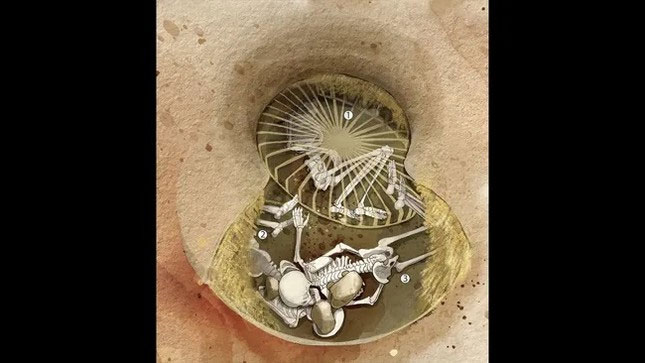Stone Age women in Europe were tied up and buried alive in sacrificial rituals
A new study has found evidence of the Stone Age method of killing people by tying and burying women alive in sacrificial rituals at 14 sites in Europe.
The incaprettamento method, binding and burying alive
The practice of killing victims as a method of sacrifice was called "incaprettamento" : tying their bent legs behind their backs, so that they would strangle themselves to death. This appears to have been the traditional method of sacrifice across Europe since the Neolithic period , more than 2,000 years ago. A new study has identified more than a dozen such incidents.

The tomb at Saint-Paul-Trois-Châteaux near Avignon, France contains the skeletons of three women buried around 5400 BC. Two of them were believed to be sacrificial victims. (Photo: Ludes et al., Sci).
The research comes after re-evaluating an ancient tomb discovered more than 2,000 years ago at Saint-Paul-Trois-Châteaux near Avignon, southern France. The tomb simulates a grain silo and contains the remains of three women buried there about 5,500 years ago.
This new research was published on April 10 in the journal Science Advances. The study reinterprets the positions of two of the skeletons and suggests that the individuals were intentionally killed – first by tying them up in a manner known as 'incaprettamento' and then burying them alive, perhaps to perform an agricultural ritual.
Many agricultural symbols in the tomb
Senior study author Eric Crubézy, a biological anthropologist at Paul Sabatier University in Toulouse, France, said there were many agricultural symbols in the tomb. A wooden structure built on it was aligned with the sun, and some broken stones for grinding grain were found nearby, he noted.
To investigate the idea of human sacrifice at Saint-Paul-Trois-Châteaux, Crubézy, who discovered the first tomb, and his colleagues examined previous archaeological studies of the sites. mausoleums across Europe.
They found evidence of 20 possible cases of sacrifice using incaprettamento at 14 Neolithic (New Stone Age) sites dating from 5400 to 3500 BC. They also found papers describing Neolithic rock art in the Addaura Caves in Sicily, done between 14,000 and 11,000 BC, that appear to depict two human figures being tortured. tied incaprettamento style.
Crubézy said it appears that incaprettamento originated as a sacrificial custom in the Neolithic period, before agriculture, and was then used for human sacrifice associated with agriculture in the Mesolithic period. new stone.
As a method of human sacrifice, incaprettamento appears to have been widespread throughout much of Neolithic Europe, with evidence at sites from the Czech Republic (graves dated to 5,400 BC). to Spain (the tomb existed for more than 2,000 years).
Savage murders
Crubézy said the ropes used to tie up the two individuals at Saint-Paul-Trois-Châteaux, southern France, had long since rotted, but some features of their skeletons - such as their unusual position - had long since rotted. of the legs - shows how they died.
Researchers noticed that the third woman in the tomb appeared to be older and may have died naturally. At that time, she was also buried normally, lying on her side in the center of the mausoleum. This suggests that she was buried after her natural death and that two younger women were buried with her as a means of sacrifice.
The two sacrificial victims appeared to have been pinned down with heavy pieces of stone used to grind grain, he said, suggesting that, although tied, they were still alive when buried.
Today, the gruesome incaprettamento murder method is associated with the Italian mafia, who sometimes use it as a form of warning or punishment.
- Surprised by the sacrificial dog skeleton 1,000 years ago in Peru
- Horror of the 140-year-old collective sacrifice ceremony 500 years ago
- Survival skills when buried alive in coffins
- Mysterious decoding of children's skulls scattered around the lake in Switzerland
- The unbelievable story of the king would rather be buried alive than surrender
- Cromlec stone rings and legends of mystical women
- 8 religious rituals in the world
- Scary psychological treatments by ... buried alive
- Discovering bones' 2,000-year-old ancient vampire in England
- Top incredible mysteries about ancient Rome
- NASA introduces radar to help detect buried survivors
- The oldest stone masks in the world
 Discovered an ancient centipede fossil 99 million years old
Discovered an ancient centipede fossil 99 million years old Discovered bat-like dinosaurs in China
Discovered bat-like dinosaurs in China Discovered a 200-year-old bronze cannon of the coast
Discovered a 200-year-old bronze cannon of the coast Discover 305 million-year-old spider fossils
Discover 305 million-year-old spider fossils